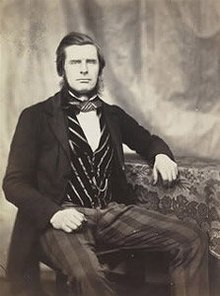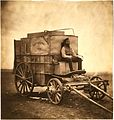Roger Fenton

Roger Fenton (born March 28, 1819 in Crimble Hall near Heywood , Lancashire , † August 8, 1869 in Potters Bar , then in Middlesex , now in Hertfordshire ) was a British lawyer and photographer . He was best known for around 360 photos he took during the Crimean War .
Life and work
Fenton was born in 1819 to the industrialist and later MP John Fenton. In London , Fenton studied mathematics, Greek and Latin. Then he began to study law and devoted himself increasingly to painting. In Paris he studied art and among other things learned from the history painter Paul Delaroche . In 1853 Fenton was a founding member of the Photographic Society (later the Royal Photographic Society ).
In 1854 Fenton ended his work as a lawyer for the time being and devoted himself full-time to photography. In the same year he made a series of portraits of the English royal family, a work that he continued until 1857. In 1855 he documented the Crimean War that had broken out two years earlier. In addition to numerous architecture and landscape shots, Fenton also photographed cricket games, royal shooting events and the Sardinian War of 1859 in the following years . In 1862 he finished his work as a photographer. Fenton had all of his photography equipment auctioned and returned to his profession as a lawyer. He died in 1869 at the age of 50.
Crimean War
Fenton is considered by many today to be one of the first war photographers . However, because of the long exposure times required at the time, he was not able to photograph combat operations. Most of his photographs are posed. Among the around 360 photos that Fenton took during the war, there are around 290 portraits or alleged everyday scenes from the life of the English army. Most of the people depicted, however, were officers. Fenton only photographed the common soldier as a marginal figure. Fenton's trip to Crimea is often viewed as a propaganda mission. The British Crown is said to have strictly forbidden him to take photographs of wounded or dead soldiers.
Fenton returned to Great Britain before the end of the Crimean War, where he was received by Queen Victoria , among others . James Robertson and Felice Beato continued his work on site .
equipment
Fenton took photographs in the Crimean War with a 40 × 50 cm camera and photo plates . The glass plates he coated immediately before recording in a mobile darkroom ( horse cart ) with photosensitive collodion . The wet collodion process made removal from the darkroom impossible, which severely limited the photographer's radius.
Roger Fenton: Self-Portrait as a Zuave , 1856
Roger Fenton's mobile darkroom in 1855 (on the driver's seat : Marcus Sparling).
Fenton's picture arrangement
Example:
literature
- Ute Daniel: The Crimean War 1853–1856 and the origins of media war reporting . In: Ute Daniel (Ed.): Eyewitnesses. War reporting from the 18th to the 21st century . Göttingen 2006, p. 40-67 .
- Ulrich Keller: The Ultimate Spectacle. A Visual History of the Crimean War . Amsterdam 2001.
- Klaus Kreimeier: War Photography . In: Waltraud Wende (Hrsg.): War and memory . Würzburg 2005, p. 285-305 .
Web links
Individual evidence
| personal data | |
|---|---|
| SURNAME | Fenton, Roger |
| BRIEF DESCRIPTION | British lawyer and photographer |
| DATE OF BIRTH | March 28, 1819 |
| PLACE OF BIRTH | Crimble Hall at Heywood , Lancashire |
| DATE OF DEATH | August 8, 1869 |
| Place of death | Potters Bar , Hertfordshire |






